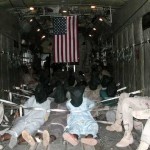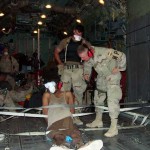Perhaps David Icke is right. Perhaps world leaders are reptiles with the ability to shape-shift to appear human. Sometimes they don’t do a good job at the disguise.
If rendition, abuse, incarceration without trial, torture, murder, and all the other horrors of the War of Terror elicit neither excuses nor apologies from the war architects, then surely the knowledge that children as young as 8 have been routinely detained, abused (often sodomised) and even murdered (and we’re not talking about the death of children from bombs – something that happens in any conflict), at the hands of US military and CIA, would cause someone in power to offer even the mildest of condemnation. Alas no. Politics trumps essential humanity on every count.
If the British government demands that writers visiting a shool to read to a large group are required to obtain a Criminal Records Check prove that they are not paedophiles (see Guardian July ’09 – the essential argument being, again, guilty until proven innocent), and if the same government is demanding that its own politicians carry out a similar ridiculous vetting process (but I bet they claim the £64 on expenses) (see Guardian July ’09), then how can it possibly be that someone like Milliband issues no criticism or condemnation of the wholesale abuse and murder of hundreds of children? Milliband’s repeated poe-faced defence of witholding information (‘classified intel’) on the grounds that it would be a threat to national security is an insult to his own cabinet, to his government, and to the people of the UK.
Unless, of course, he is a lizard. In which case such human attributes as compassion, remorse, and forgiveness are simply alien concepts.
Am I reduced to this most fantastic of ideas as a means of reconciling myself to the utter brutality of this long and costly conflict?
“President Jimmy Carter wrote that the Red Cross, Amnesty International and the Pentagon “have gathered substantial testimony of torture of children, confirmed by soldiers who witnessed or participated in the abuse.” In “Our Endangered Values” Carter said that the Red Cross found after visiting six U.S. prisons “107 detainees under eighteen, some as young as eight years old.” And reporter Hersh, (who broke the Abu Ghraib torture scandal,) reported 800-900 Pakistani boys aged 13 to 15 in custody.” (President Carter: Many Children Were Tortured Under Bush Thepeoplesvoice.org)
” Some of the worst things that happened you don’t know about, okay? Videos, um, there are women there. Some of you may have read that they were passing letters out, communications out to their men. This is at Abu Ghraib … The women were passing messages out saying ‘Please come and kill me, because of what’s happened’ and basically what happened is that those women who were arrested with young boys, children in cases that have been recorded. The boys were sodomized with the cameras rolling. And the worst above all of that is the soundtrack of the boys shrieking that your government has. They are in total terror. It’s going to come out.” (Seymour Hersh Thepeoplesvoice.org)
The following is all copied from the article quoted above in Thepeoplesvoice.
— Iraqi lawyer Sahar Yasiri, representing the Federation of Prisoners and Political Prisoners, said in a published interview there are more than 400,000 detainees in Iraq being held in 36 prisons and camps and that 95 percent of the 10,000 women among them have been raped. Children, he said, “suffer from torture, rape, (and) starvation” and do not know why they have been arrested. He added the children have been victims of “random” arrests “not based on any legal text.”
— Former prisoner Thaar Salman Dawod in a witness statement said, “[I saw] two boys naked and they were cuffed together face to face and [a U.S. soldier] was beating them and a group of guards were watching and taking pictures and there was three female soldiers laughing at the prisoners.”
— Iraqi TV reporter, Suhaib Badr-Addin al-Baz, arrested while making a documentary and thrown into Abu Ghraib for 74 days, told Mackay he saw “hundreds” of children there. Al-Baz said he heard one 12-year-old girl crying, “They have undressed me. They have poured water over me.” He said he heard her whimpering daily.
— Al-Baz also told of a 15-year-old boy “who was soaked repeatedly with hoses until he collapsed.” Amnesty International said ex-detainees reported boys as young as 10 are held at Abu Ghraib.
— German TV reporter Thomas Reutter of “Report Mainz” quoted U.S. Army Sgt. Samuel Provance that interrogation specialists “poured water” over one 16-year-old Iraqi boy, drove him throughout a cold night, “smeared him with mud” and then showed him to his father, who was also in custody. Apparently, one tactic employed by the Bush regime is to elicit confessions from adults by dragging their abused children in front of them.
— Jonathan Steele, wrote in the British “The Guardian” that “Hundreds of children, some as young as nine, are being held in appalling conditions in Baghdad’s prisons…Sixteen-year-old Omar Ali told the “Guardian” he spent more than three years at Karkh juvenile prison sleeping with 75 boys to a cell that is just five by 10 meters, some of them on the floor. Omar told the paper guards often take boys to a separate room in the prison and rape them.
— Raad Jamal, age 17, was taken from his Doura home by U.S. troops and turned over to the Iraqi Army’s Second regiment where Jamal said he was hung from the ceiling by ropes and beaten with electric cables.
— Human Rights Watch (HRW) last June put the number of juveniles detained at 513. In all, HRW estimates, since 2003, the U.S. has detained 2,400 children in Iraq, some as young as ten.
— IRIN, the humanitarian news service, last year quoted Khalid Rabia of the Iraqi NGO Prisoners’ Association for Justice(PAJ), stating that five boys between 13 and 17 accused of supporting insurgents and detained by the Iraqi army “showed signs of torture all over their bodies,” such as “cigarette burns over their legs,” she said.
— One boy of 13 arrested in Afghanistan in 2002 was held in solitary for more than a year at Bagram and Guantanamo and made to stand in stress position and deprived of sleep, according to the “Catholic Worker.” (Thepeoplesvoice.org)
Follow this link to TRUTHOUT.ORG, for a long extract from Henry A. Giroux’s forthcoming book, “Hearts of Darkness: Torturing Children in the War on Terror,” to be published by Paradigm Publishers.
Today (Aug 27th) in the Times, an article about Mohammed Jawad – ‘I was 12 when I was arrested and sent to Guantanamo’









